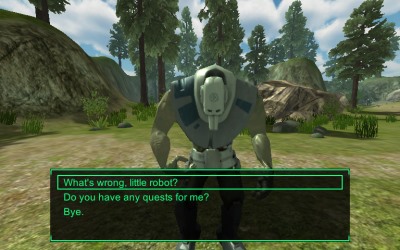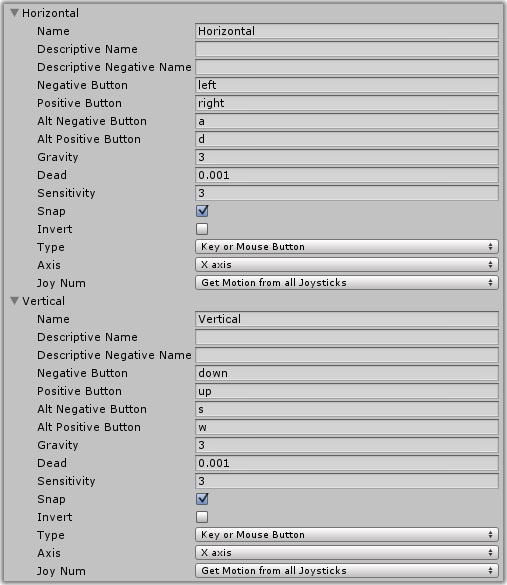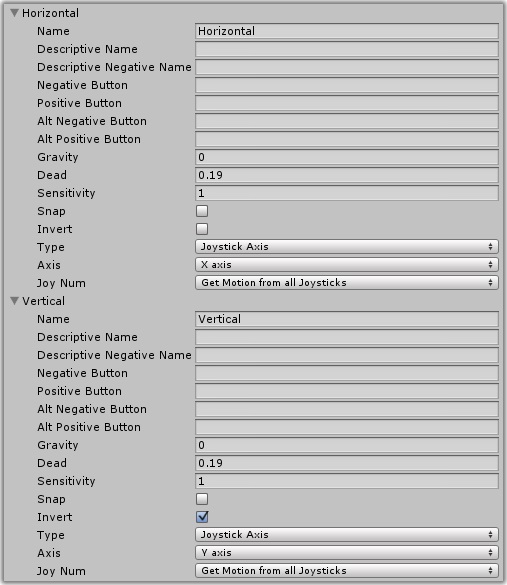
(Click Here for Video Tutorial)
This page describes how to set up the Dialogue System with Azuline Studios' Realistic FPS Prefab. (Realistic FPS Prefab v1.23+ is required.)
Realistic FPS Prefab copyright © Azuline Studios.
There is a separate page for Realistic FPS Prefab / S-Inventory integration. You should familiarize yourself with the basics of S-Inventory integration before reading the Realistic FPS Prefab / S-Inventory page.
If you're using RFPS 1.2 (and not RFPS 1.4+), select Edit > Project Settings > Player. To the Inspector's Scripting Define Symbols field, add RFPS_1_2. If this field already contains symbols, separate them with a semicolon ( ; ).
Third Party Support/Realistic FPS Prefab Support. This will unpack files into the folder Third Party Support/Realistic FPS Prefab.

At this point you can jump to the Example Scenes if you'd like to get a preview of how the integration works before continuing to set up your own scene.
Once you've imported the packages and fixed the Input Manager, follow these steps to set up your scene:
Delay({{end}}) to delay without moving the camera. (The default Dialogue Manager prefab is already configured this way.) Since the player doesn't have a body, it doesn't make sense to move the camera into a closeup on the conversation participants.FPS Camera > Main Camera GameObject. Then select Component > Dialogue System > Actor > Player > Selector. This will add a selector that you can use to interact with Dialogue System usable objects. If you plan to use RFPS's interaction system instead, skip this step.FPS Main GameObject or the FPS Player child GameObject. Then select Component > Dialogue System > Third Party > Realistic FPS Prefab > Disable Gameplay In Conversations. This will add components to FPS Player to make it work smoothly with the Dialogue System, as described in How to Disable Player Control During Conversations.FPS Player (or do it manually with Component > Dialogue System > Third Party > Realistic FPS Prefab > FPS Lua Bridge). This component syncs RFPS and the Dialogue System, as described in How to Disable Player Control During Conversations.You may be interested in using Unity UI to show HUD elements such as ammo text. Here are unofficial instructions: http://www.pixelcrushers.com/how-to-use-unity-ui-for-ammo-text-in-realistic-fps-prefab/
During conversations, you will usually want to disable player movement and camera control. To do this, select the player prefab. Then select Component > Dialogue System > Third Party > Realistic FPS Prefab > Disable Player On Conversation. (Note that if you plan to use the Dialogue System's selector/usable system, add a Selector component to the Main Camera GameObject first.
The Disable Player On Conversation menu item will add and configure Set Active On Dialogue Event and Set Enabled On Dialogue Event components. These components will deactivate Realistic FPS Prefab components when the player starts a conversation, and reactivate them when the conversation ends.
If you want to control the camera during conversations and cutscene sequences, control the FPSPlayer GameObject. The camera and visible body will follow it as described below:
Visible Body
If your player uses a visible body, the integration will also configure the player to disable the Visible Body component and play the idle animation when a conversation starts. The body will follow the FPSPlayer's position at the offset it has when the conversation starts.
Camera Kick
The integration will disable the Camera Kick component during conversations. The camera will follow the FPSPlayer's position at the offset it has when the conversation starts.
During conversations, you will usually want to disable NPC AI on the NPC that the player is talking to. Otherwise the NPC could wander away or get into a fight while the player is trying to converse.
To do this, add a Pause AI On Conversation component to the NPC.
Note that other NPCs are not paused. This only applies to the NPC involved in the conversation. You may want to make sure this NPC is placed away from danger so enemies don't interrupt the conversation.
To make an NPC break off conversation if it gets hurt, you must edit the Realistic FPS Prefab script CharacterDamage.cs. Make these two changes:
At some point, you may want to activate another NPC during a conversation. For example, in a conversation with a mob boss, the player accepts a quest to escort the boss's son from jail to home. The son GameObject was previously inactive. If you use the SetActive() sequencer command, the son's AI component will fail to initialize. This is because it looks for certain active RFPS components on the player GameObject. But these components are inactive during conversations. Here are two solutions to this issue:
Use these steps to make NPCs' positions and living/dead states persistent.
CharacterDamage.cs script in two places.On line 7 (after public class CharacterDamage : MonoBehaviour {) add:
On line ~180, change this section of the ApplyDamage method from:
to:
The Dialogue System On Pick Up Item script can be attached to any Pickup object. (When configuring Pickup objects, remember to set the tag to Usable and the layer to Ragdoll/Pickups.)
When the player picks up the object, this script will perform various actions. You can use it to advance quests, show gameplay alerts, run Lua code, play sequences, and send messages (for example, send an "OnUse" message to a traditional Dialogue System trigger). If you want to remove the object from the scene when it's picked up, tick Destroy.
If you configure this component to send "OnUse" to its own GameObject, you can cleanly integrate RFPS's interaction system with the Dialogue System's trigger system. For example, you can add a Conversation Trigger to a GameObject and set the trigger event to "OnUse". Then add a Dialogue System On Pick Up Item to the same GameObject and configure it to send "OnUse" to itself.
(This component has been deprecated by the more full-featured Dialogue System On Pick Up Item component described above.)
The Lua On Pick Up Item script can be attached to any Pickup object. When the player picks up the object, this script will run a Lua command. In the example scene, the Shotgun Pickup uses this script to display a gameplay alert message.
The Lua On Destroy script can be attached to any object. When the object is destroyed, the script will run Lua code. You can add this to an enemy to update the kill count when the enemy is destroyed. An alternative is the Increment On Destroy component.
For examples of saving and loading games, refer to the Multiple Scene Example.
You can use the Game Saver component to save without having to write any scripts, as demonstrated in the Main Menu Scene.
You can also save and load in script, as demonstrated in the Gameplay Scenes.
If you use PlayMaker, you can use PlayMaker's Save & Load Actions. To save, use the Record Savegame Data to record the current state of the game in a string. Then save this string however you want. To reload the saved game, retrieve this string and send it to the Apply Savegame Data action.
If you want saved games to record the state of objects in the game, you must add persistent data components such as Persistent Position Data and Persistent Destructible. See the Save System documentation for more details.
To record the player's position and rotation, inspect the FPS Lua Bridge on FPS Player and tick Save Position.
The FPS Lua Bridge synchronizes data between the Realistic FPS Prefab player and the Dialogue System's Lua environment. It automatically synchronizes before and after conversations, and you can synchronize manually using SyncFPSToLua() and SyncLuaToFPS(). It also registers some Lua functions that you can use in conversations, conditions, and Lua Triggers.
The bridge uses the following values in the Lua environment:
| Lua value | Description |
|---|---|
Actor["Player"].hitPoints | Current hit points |
Actor["Player"].maximumHitPoints | Maximum hit points |
Actor["Player"].hungerPoints | Current hunger points |
Actor["Player"].thirstPoints | Current thirst points |
Actor["Player"].invulnerable | Current invulnerability state (true or false) |
Actor["Player"].currentWeaponIndex | Index of currently-equipped weapon (0=unarmed, 1=knife, etc.) |
Variable["(weaponname)"] | A Boolean (true or false) indicating whether the player has the named weapon |
Variable["(weaponname)_Ammo"] | An integer indicating how much ammo the player has for the named weapon |
To check if the player has a shotgun:
Variable["Shotgun"] == true
To take the shotgun away from the player:
Variable["Shotgun"] = false
To completely heal the player:
Actor["Player"].hitPoints = Actor["Player"].maximumHitPoints
The bridge also hides the HUD during conversations if you tick Hide Hud In Conversations.
Add the Sync Lua To FPS On Load Level component to the Dialogue Manager if the player will move between scenes, including appearing in a gameplay scene from a menu scene.
The bridge adds these four Lua functions:
GetRfpsFaction(subject)
Given a subject name (a string that matches a GameObject name in the scene), this function returns a number indicating the subject's faction:
| Value | Faction |
|---|---|
| 1 | Friendly to player |
| 2 | Hostile to player (Alien) |
| 3 | Hostile to all other factions (Zombie) |
If no GameObject matches the subject name, this function returns 1.
Example: You can set a dialogue entry's Conditions field to the value below to only use that entry if "Sad Robot" is friendly:
SetRfpsFaction(subject, faction)
Given a subject name (a string that matches a GameObject name in the scene), sets the subject's faction. The faction values are listed in the table above. Example: You can set a dialogue entry's Script field to the value below to make "Sad Robot" hostile:
The "Sad Robot" conversation runs a quest to get a shotgun for the sad robot. It manages the quest, and also checks whether Variable["Shotgun"] == true. If it's true, it offers the player the option of giving the shotgun to the sad robot. If the player gives the shotgun to the sad robot, the conversation runs the script Variable["Shotgun"] = false to remove the shotgun from the player's inventory.
After giving the sad robot a shotgun, you can choose a dialogue entry that changes its faction to aggressive. This uses the SetRfpsFaction() Lua function.
The "Happy Robot" conversation tests giving and taking weapons and ammo, and reporting health.
If you enter the back of the house, you'll trigger the "Kill 4 Zombies" quest. This uses the Quest Trigger component to start the quest and Increment On Destroy on each house zombie to increment the kill counter. Another Quest Trigger outside each door of the house checks the status of the quest.
You may notice two quirks:
PersistentDataManager.LevelWillBeUnloaded() before loading or reloading a level. This tells components such as Lua On Destroy to ignore the OnDestroy message that's generated when an old level is unloaded.The integration package doesn't include a multiple scene example any more (to keep the package reasonably small), but it's fairly easy to set up multiple scenes. In brief, the steps are: